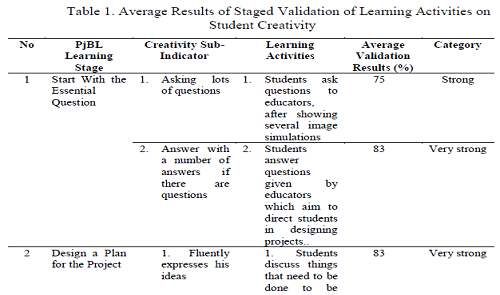
Feasibility Analysis of Stem-PjBL Mod El to Build Creativity and Communication Capabilities of Students
Abstract
Keywords
Full Text:
PDFReferences
Al-Abdali, N. S., & Al-Balushi, S. M. (2016). Teaching for creativity by science teachers in grades 5–10. International Journal of Science and Mathematics Education, 14(2), 251-268.
Arizona, K., Abidin, Z., & Rumansyah, R. (2020). Pembelajaran online berbasis proyek salah satu solusi kegiatan belajar mengajar di tengah pandemi covid-19. Jurnal Ilmiah Profesi Pendidikan, 5(1), 64-70.Al-Abdali, N. S., & Al-Balushi, S. M. (2016). Teaching for creativity by science teachers in grades 5–10. International Journal of Science and Mathematics Education, 14(2), 251-268.
Febriana, D. F. (2016). Profil Berpikir Kreatif Siswa SMP Berkecerdasan Linguistik, Logis-Matematis, Dan Visual-Spasial Dalam Menyelesaikan Masalah Persegipanjang. MATHEdunesa, 5(2).
Hanif, S., Wijaya, A. F. C., & Winarno, N. (2019). Enhancing Students' Creativity through STEM Project-Based Learning. Journal of science Learning, 2(2), 50-57.
Jho, H., Hong, O., & Song, J. (2016). An analysis of STEM/STEAM teacher education in Korea with a case study of two schools from a community of practice perspective. Eurasia Journal of Mathematics, Science and Technology Education, 12(7), 1843-1862.
Lou, S. J., Chou, Y. C., Shih, R. C., & Chung, C. C. (2017). A study of creativity in CaC2 steamship-derived STEM project-based learning. Eurasia Journal of Mathematics, Science and Technology Education, 13(6), 2387-2404.
Mukaromah, S. H., & Wusqo, I. U. (2020). The influence of PjBL model with stem approach on global warming topic to students’ creative thinking and communication skills. In Journal of Physics: Conference Series (Vol. 1521, No. 4, p. 042052). IOP Publishing.
Oktaviani, F., & Hidayat, T. (2010). Profil keterampilan berkomunikasi siswa sma menggunakan metode fenetik dalam pembelajaran klasifikasi arthropoda. Jurnal Pengajaran MIPA, 15(1), 13-24.
Setiawan, B. B., Kurniasari, M. R., & Sarkim, T. (2020). The implementation of STEM approach through project based learning to develop student’s creativity. In Journal of Physics: Conference Series (Vol. 1470, No. 1, p. 012041). IOP Publishing.
Siew, N. M., & Ambo, N. (2020). The Scientific Creativity of Fifth Graders in a STEM Project-Based Cooperative Learning Approach. Problems of Education in the 21st Century, 78(4), 627-643.
Triana, D., Anggraito, Y. U., & Ridlo, S. (2020). Effectiveness of environmental change learning tools based on STEM-PjBL towards 4C skills of students. Journal of Innovative Science Education, 9(2), 181-187.
Wena, I. M. (2020). Perkuliahan online dengan aplikasi zoom dalam program belajar dari rumah dimasa pandemi Covid-19. Prosiding Webinar Nasional Universitas Mahasaraswati Denpasar 2020.
Wibawanto, T. (2020). Pemanfaatan video conference dalam pembelajaran tatap muka jarak jauh dalam rangka belajar dari rumah. Jurnal Teknologi Pendidikan, 1(1), 1-9.
DOI: http://dx.doi.org/10.31258/jes.6.2.p.236-247
Refbacks
- There are currently no refbacks.
Copyright (c) 2022 Nensia Viorita

This work is licensed under a Creative Commons Attribution 4.0 International License.
Publisher: FKIP Universitas Riau












